Ottawa/Import/Trees
Tree Inventory[1] is a dataset containing 149,146 trees mostly owned by the City of Ottawa located along their road allowances.
Overview
This dataset is available on the City of Ottawa's open data portal, as part of a government initiative for open data.[2]
The availability of this data on OSM could benefit users in searching for or creating a map of trees within the city. For example, fruit-bearing trees that can be harvested for consumption.
Licence
Open Data Licence Version 2.0[3] (Approved by the Licence Working Group)
Data Collection
From the dataset source page:
"This data was collected in the field using GPS software on handheld computers"
Data
The data is a modified OSM file that originated from a KMZ file on the Ottawa Data Portal.[4]
Preview
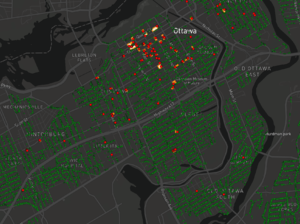
You can preview the data here: https://api.mapbox.com/styles/v1/addxy/cj4nm39du4esb2qlg0jjlvwiv.html
Tags
The KMZ format had tags that are not usable in an OSM format and thus had to be cleaned and modified with proper OSM tags. All that remains from the source data is the width, object id number, and common name of species.
Entries without OSM tags were removed from the source data.
Entries with only OSM tags were not part of the original dataset and were manually added based on research (meaning a quick Wikipedia search)
| Original Key | OSM Tag | Example | Description |
|---|---|---|---|
| leaf_cycle | deciduous | Describes if the leaves fall off or not | |
| leaf_type | broadleaved | Describes if the tree has needles or leaves | |
| natural | tree | Defines the node as a tree | |
| survey:date | 2013 | When the trees were surveyed | |
| genus | Popolus | Latin name for genus | |
| genus:en | Poplar | English name for genus | |
| taxon:cultivar | Italica | Cultivar of the tree (if it has one) | |
| species | Populus Nigra | Latin name for species | |
| SPECIES | species:en | Lombardy Poplar | English name for species |
| OBJECTID | ref | 72027 | |
| DBH | circumference | 0.41 | The circumference of the tree in centimetres calculated from the (Diameter at Breast Height - in meters)
Calculation: (DBH * π / 100) |
| ADDNUM | 40 | Civic number associated with the trees location | |
| ADDSTR | ROYAL FIELD CRES | Street name associated with the trees location | |
| RDLOCATION | Boulevard | Is the tree located in a Median, Boulevard etc | |
| LTLOCATION | Rear | Is the tree located on the side/front of the parcel | |
| DEDTAGNUMB | 0 | Tag number associated with Elm trees involved in the DED injection program | |
| EABTAGNUMB | 0 | Tag number associated with Ash trees involved in the EAB injection program | |
| NAME | kml_119561 | ||
| WARD | 3 | What ward is the tree located in |
Common and Latin names
This is the information used to create the species and genus tags. The genus and genus:en tags are simply the first words of each column.
| English name | Latin Genus and Species | Leaf type | Leaf Cycle |
|---|---|---|---|
| Amur Maple | Acer ginnala on Wikipedia | broadleaved | deciduous |
| Bigleaf Maple | Acer macrophyllum on Wikipedia | broadleaved | deciduous |
| Manitoba Maple | Acer negundo on Wikipedia | broadleaved | deciduous |
| Black Maple | Acer nigrum on Wikipedia | broadleaved | deciduous |
| Japanese Maple | Acer palmatum on Wikipedia | broadleaved | deciduous |
| Striped Maple | Acer pensylvanicum on Wikipedia | broadleaved | deciduous |
| Norway Maple | Acer platanoides on Wikipedia | broadleaved | deciduous |
| Red Maple | Acer rubrum on Wikipedia | broadleaved | deciduous |
| Silver Maple | Acer saccharinum on Wikipedia | broadleaved | deciduous |
| Sugar Maple | Acer saccharum on Wikipedia | broadleaved | deciduous |
| Tatarian Maple | Acer tataricum on Wikipedia | broadleaved | deciduous |
| Ohio Buckeye | Aesculus glabra on Wikipedia | broadleaved | deciduous |
| Horse-Chestnut | Aesculus hippocastanum on Wikipedia | broadleaved | deciduous |
| Yellow Birch | Betula alleghaniensis on Wikipedia | broadleaved | deciduous |
| Alaskan Birch | Betula neoalaskana on Wikipedia | broadleaved | deciduous |
| River Birch | Betula nigra on Wikipedia | broadleaved | deciduous |
| White Birch | Betula papyrifera on Wikipedia | broadleaved | deciduous |
| Gray Birch | Betula populifolia on Wikipedia | broadleaved | deciduous |
| Himalayan Birch | Betula utilis on Wikipedia | broadleaved | deciduous |
| Bitternut Hickory | Carya cordiformis on Wikipedia | broadleaved | deciduous |
| Shagbark Hickory | Carya ovata on Wikipedia | broadleaved | deciduous |
| Northern Catalpa | Catalpa speciosa on Wikipedia | broadleaved | deciduous |
| Katsura | Cercidiphyllum japonicum on Wikipedia | broadleaved | deciduous |
| Eastern Redbud | Cercis canadensis on Wikipedia | broadleaved | deciduous |
| Red Osier Dogwood | Cornus sericea on Wikipedia | broadleaved | deciduous |
| American Hazelnut | Corylus americana on Wikipedia | broadleaved | deciduous |
| Turkish Hazel | Corylus colurna on Wikipedia | broadleaved | deciduous |
| European Smoketree | Cotinus coggygria on Wikipedia | broadleaved | deciduous |
| Russian Olive | Elaeagnus angustifolia on Wikipedia | broadleaved | deciduous |
| Black Walnut | Juglans Nigra on Wikipedia | broadleaved | deciduous |
| American Wahoo | Euonymus atropurpureus on Wikipedia | broadleaved | deciduous |
| American Beech | Fagus grandifolia on Wikipedia | broadleaved | deciduous |
| Blue Beech | Fagus japonica on Wikipedia | broadleaved | deciduous |
| European Beech | Fagus sylvatica on Wikipedia | broadleaved | deciduous |
| White Ash | Fraxinus americana on Wikipedia | broadleaved | deciduous |
| European Ash | Fraxinus excelsior on Wikipedia | broadleaved | deciduous |
| Black Ash | Fraxinus nigra on Wikipedia | broadleaved | deciduous |
| Green Ash | Fraxinus pennsylvanica on Wikipedia | broadleaved | deciduous |
| Ginkgo | Ginkgo biloba on Wikipedia | broadleaved | deciduous |
| Honey Locust | Gleditsia triacanthos on Wikipedia | broadleaved | deciduous |
| Kentucky Coffeetree | Gymnocladus dioicus on Wikipedia | broadleaved | deciduous |
| Butternut | Juglans cinerea on Wikipedia | broadleaved | deciduous |
| Golden Chain | Laburnum anagyroides on Wikipedia | broadleaved | deciduous |
| Tulip Tree | Liriodendron tulipifera on Wikipedia | broadleaved | deciduous |
| Amur Cork Tree | Phellodendron amurense on Wikipedia | broadleaved | deciduous |
| American Sycamore | Platanus occidentalis on Wikipedia | broadleaved | deciduous |
| White Poplar | Populus alba on Wikipedia | broadleaved | deciduous |
| Balsam Poplar | Populus balsamifera on Wikipedia | broadleaved | deciduous |
| Eastern Cottonwood | Populus deltoides on Wikipedia | broadleaved | deciduous |
| Large-Tooth Aspen | Populus grandidentata on Wikipedia | broadleaved | deciduous |
| Lombardy Poplar | Populus nigra on Wikipedia | broadleaved | deciduous |
| Trembling Aspen | Populus tremuloides on Wikipedia | broadleaved | deciduous |
| Pin Cherry | Prunus pensylvanica on Wikipedia | broadleaved | deciduous |
| Black Cherry | Prunus serotina on Wikipedia | broadleaved | deciduous |
| Flowering Almond | Prunus triloba on Wikipedia | broadleaved | deciduous |
| Schubert Choke Cherry | Prunus virginiana on Wikipedia | broadleaved | deciduous |
| Choke Cherry | Prunus virginiana on Wikipedia | broadleaved | deciduous |
| Common Hoptree | Ptelea trifoliata on Wikipedia | broadleaved | deciduous |
| White Oak | Quercus alba on Wikipedia | broadleaved | deciduous |
| Swamp White Oak | Quercus bicolor on Wikipedia | broadleaved | deciduous |
| Bur Oak | Quercus macrocarpa on Wikipedia | broadleaved | deciduous |
| Pin Oak | Quercus palustris on Wikipedia | broadleaved | deciduous |
| English Oak | Quercus robur on Wikipedia | broadleaved | deciduous |
| Red Oak | Quercus rubra on Wikipedia | broadleaved | deciduous |
| Staghorn Sumac | Rhus typhina on Wikipedia | broadleaved | deciduous |
| Black Locust | Robinia pseudoacacia on Wikipedia | broadleaved | deciduous |
| Arctic Willow | Salix arctica on Wikipedia | broadleaved | deciduous |
| Weeping Willow | Salix babylonica on Wikipedia | broadleaved | deciduous |
| Bebb Willow | Salix bebbiana on Wikipedia | broadleaved | deciduous |
| Pussy Willow | Salix discolor on Wikipedia | broadleaved | deciduous |
| Corkscrew Willow | Salix matsudana on Wikipedia | broadleaved | deciduous |
| Black Willow | Salix nigra on Wikipedia | broadleaved | deciduous |
| European Mountain Ash | Sorbus aucuparia on Wikipedia | broadleaved | deciduous |
| Showy Mountain Ash | Sorbus decora on Wikipedia | broadleaved | deciduous |
| Swedish Whitebeam | Sorbus intermedia on Wikipedia | broadleaved | deciduous |
| Japanese Lilac | Syringa reticulata on Wikipedia | broadleaved | deciduous |
| Common Lilac | Syringa vulgaris on Wikipedia | broadleaved | deciduous |
| Basswood | Tilia americana on Wikipedia | broadleaved | deciduous |
| Littleleaf Linden | Tilia cordata on Wikipedia | broadleaved | deciduous |
| American Elm | Ulmus americana on Wikipedia | broadleaved | deciduous |
| Scotch Elm | Ulmus glabra on Wikipedia | broadleaved | deciduous |
| Chinese Elm | Ulmus parvifolia on Wikipedia | broadleaved | deciduous |
| Siberian Elm | Ulmus pumila on Wikipedia | broadleaved | deciduous |
| Red Elm | Ulmus rubra on Wikipedia | broadleaved | deciduous |
| Rock Elm | Ulmus thomasii on Wikipedia | broadleaved | deciduous |
| High Bush Cranberry | Viburnum trilobum on Wikipedia | broadleaved | deciduous |
| European Larch | Larix decidua on Wikipedia | needleleaved | deciduous |
| Eastern Larch | Larix laricina on Wikipedia | needleleaved | deciduous |
| Balsam Fir | Abies balsamea on Wikipedia | needleleaved | evergreen |
| Colorado Fir | Abies concolor on Wikipedia | needleleaved | evergreen |
| Nootka Cypress | Cupressus nootkatensis on Wikipedia | needleleaved | evergreen |
| Eastern Juniper | Juniperus virginiana on Wikipedia | needleleaved | evergreen |
| Norway Spruce | Picea abies on Wikipedia | needleleaved | evergreen |
| White Spruce | Picea glauca on Wikipedia | needleleaved | evergreen |
| Black Spruce | Picea mariana on Wikipedia | needleleaved | evergreen |
| Serbian Spruce | Picea omorika on Wikipedia | needleleaved | evergreen |
| Colorado Spruce | Picea pungens on Wikipedia | needleleaved | evergreen |
| Red Spruce | Picea rubens on Wikipedia | needleleaved | evergreen |
| Bristlecone Pine | Pinus aristata on Wikipedia | needleleaved | evergreen |
| Jack Pine | Pinus banksiana on Wikipedia | needleleaved | evergreen |
| Western White Pine | Pinus monticola on Wikipedia | needleleaved | evergreen |
| Mugo Pine | Pinus mugo on Wikipedia | needleleaved | evergreen |
| Black Pine | Pinus nigra on Wikipedia | needleleaved | evergreen |
| Parry Pinyon | Pinus quadrifolia on Wikipedia | needleleaved | evergreen |
| Red Pine | Pinus resinosa on Wikipedia | needleleaved | evergreen |
| White Pine | Pinus strobus on Wikipedia | needleleaved | evergreen |
| Scotch Pine | Pinus sylvestris on Wikipedia | needleleaved | evergreen |
| Douglas Fir | Pseudotsuga menziesii on Wikipedia | needleleaved | evergreen |
| Canada Yew | Taxus canadensis on Wikipedia | needleleaved | evergreen |
| Eastern White Cedar | Thuja occidentalis on Wikipedia | needleleaved | evergreen |
Import Process
The process will be dealt with using the osm-ca Tasking Manager to ease the work flow as there is a lot of data to be added.
The time frame can expect to be a week or two after getting approval from the community.
Issues
Merging with current trees in OSM
There are about 6,021 trees in OSM within the area of the dataset. Of those, only 3 have anything more than natural=tree and none of them overlap with what is being imported. If any of the remaining 6,021 trees are overlapping with the dataset a simple use of the m key to merge the existing node to the new one will fix this and retain history of said node.
Tree thickness

There are 7 trees with an outlying thickness. All trees are below 9.42m round (3m thick). There's a gap from 3m to 4.5m diameter and then 6 trees between 4.5m and 7m diameter. One tree is listed as being 55m thick. Unless Ottawa hosts the thickest tree in the world that no one knows about then this is certainly not correct.
These 7 trees will be tagged with a fixme to indicate their thickness are not correct and a ground survey is required.
| ref | Circumference | Diameter | Notes |
|---|---|---|---|
| 25019 | 14.14 | 4.50 | Based on imagery, it seems like this tree was dug up and a large hole left in its place.
This may have been an accurate measurement and not an error. |
| 20369 | 14.99 | 4.77 | |
| 25169 | 14.99 | 4.77 | |
| 40401 | 15.99 | 5.09 | |
| 5025 | 21.61 | 6.88 | |
| 22578 | 21.99 | 7.00 | |
| 6768 | 174.83 | 55.65 |
Trees inside OSM Buildings
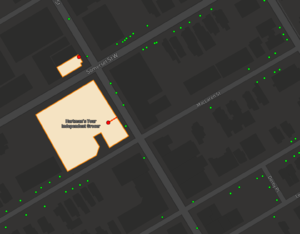
Only 210 trees conflict (fall inside) existing OSM buildings (as of 2017 July 2), these trees will be excluded from the import data and will be handled manually.
Trees which conflicts with buildings can be downloaded here: https://gist.github.com/DenisCarriere/bf7b3a8812516882b6ba510ed979b390
A breakdown of the conflicts based on distance (how far away the tree is from the closest edge of the building)
- 0 meter => 210 conflicts
- 1 meter => 120 conflicts
- 3 meters => 44 conflicts
Trees inside OSM Water
No trees in this import fall inside any water=* OSM features.
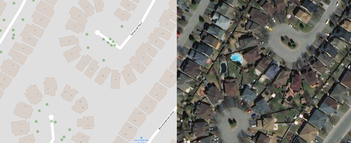
Trees nearby OSM Roads
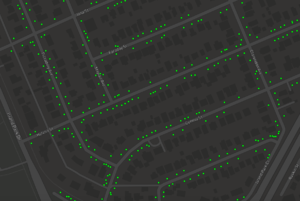
The import data is of high quality accuracy which makes is near impossible to calculate if a tree is exactly on top of a road or in proximity by 3-5 feet away from the centerline which might be the case in some residential neighborhoods. The OSM road centerline might have an offset of a few meters (1-3 meters) based on which type of imagery the road was collected. There isn't any indications that trees are located on major highways or major roads.
Import Data
The original import data has been transformed into both GeoJSON & Vector Tile (MBTiles) formats with the above OSM tags schema.
- Tree Inventory (mbtiles / geojson)
- Tree Inventory - without conflicts (mbtiles / geojson)
- Tree Inventory - only building conflicts (mbtiles / geojson)
Tasking Manager Data
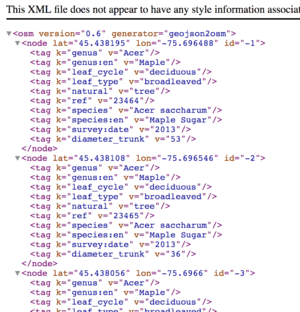
Using the Tasking Manager, the imported data is served as OSM tiles using the following schema to be added to the Per Task Instructions.